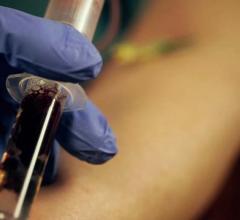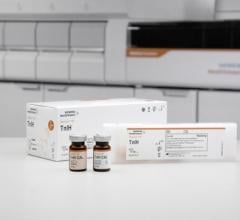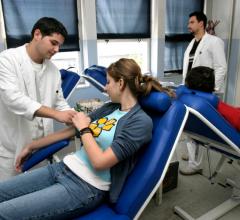
June 3, 2011 - Research presented at the International Federation of Clinical Chemistry Congress and Laboratory Medicine showed that using a lower diagnostic threshold for troponin improves clinical outcomes and patient survival in patients with suspected acute coronary syndromes. Troponin is a protein found inside heart cells that is released when they are damaged by ischemia or reduced blood supply.
Cardiac troponin is regarded by clinicians as one of the most specific biochemical markers for myocardial tissue injury, and the latest generation of more sensitive assays can identify patients with very small heart attacks. By improving the ability to accurately triage patients presenting with chest pain, the use of sensitive troponin assays could provide physicians with important information to help reduce patient deaths.
The diagnostic threshold used during the validation phase was 0.2 ng/mL. During the implementation phase, the diagnostic threshold was lowered to 0.05 ng/mL. The 2,092 patients with suspected ACS who presented at the Royal Infirmary of Edinburgh were stratified in three groups (troponin During the validation phase, 39 percent of patients with troponin concentrations of 0.05 to 0.19 ng/mL died or were readmitted with myocardial infarction (MI) at one year. In contrast, only 21 percent of patients with troponin concentrations of 0.05 to 0.19 died or had a recurrent MI during the implementation phase. Lowering the diagnostic threshold resulted in more referrals to specialists and better treatment, explaining the improvement in clinical outcomes in these patients.
Nicolas Mills, M.D., Ph.D., a cardiologist at the British Heart Foundation Centre for Cardiovascular Science, and Simon Walker, M.D., Ph.D., a senior lecturer and consultant in the Department of Clinical Biochemistry at Edinburgh University, presented data from their study at a workshop sponsored by Abbott. The session, titled "The Importance of Biomarkers in Optimizing the Treatment of Patients with Heart and Kidney Disease," reviewed findings that were published in The Journal of the American Medical Association on March 23. The research shows using a lower diagnostic threshold can improve the early diagnosis of MI by giving physicians important information to reduce the risk of death and admissions for recurrent myocardial infarction in high-risk patients. Mills and Walker used the Architect Stat Troponin-I assay to explore the clinical benefits of lowering the diagnostic threshold for detecting cardiac troponin.
"In patients with suspected acute coronary syndrome, the more sensitive threshold for troponin testing increased detection of MI by 29 percent. It also identified patients at high risk for recurrent MI and death who would benefit from access to evidenced-based therapies for MI," said Mills. "As a result, the data shows more sensitive troponin assays can improve cardiac patient management by identifying important information for physicians, and, most importantly, save lives."
Abbott's fully automated troponin assay operates on the Architect system, which enables laboratories to perform a broad menu of tests with optimal ease and efficiency. The Architect Stat Troponin-I assay is in available in some countries outside the United States.
For more information: www.abbott.com


 October 09, 2019
October 09, 2019 









